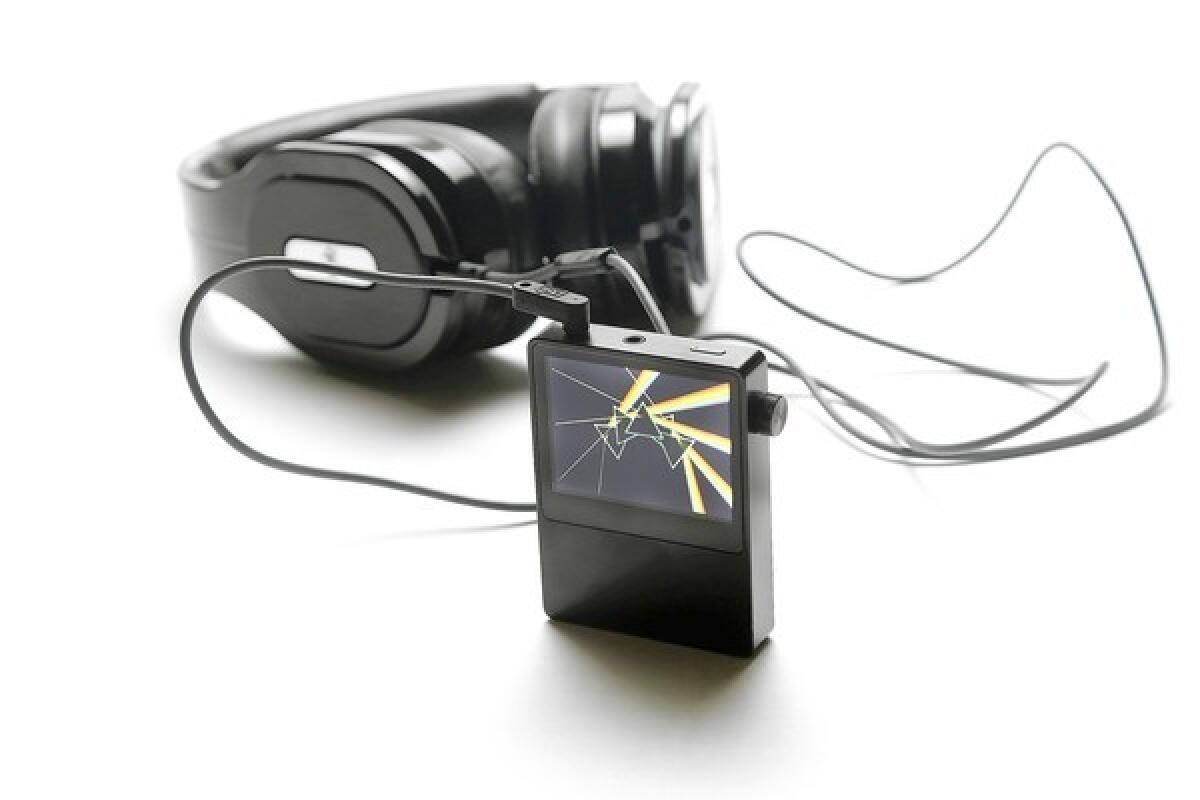AK100 from iRiver is a better-sounding (but buggy) iPod alternative

In the spirit of musical independence this Fourth, may I propose two effective, if buggy, tools for liberation? One is an iPod slayer. The other is an anti-iPod. The former plays music despite its many software bugs. The latter entices you into the realm of bug music.
Named, alas, like an automatic weapon, the Astell&Kern 100 — a.k.a. the AK100 — is a music player from the Korean electronics manufacturer iRiver. It’s the length of, and slightly wider than, an iPod nano. It has the depth of about five nanos. A clumsy volume wheel protrudes from the right side and is bound to break sooner or later. The touch screen is not especially responsive.
This player does one thing only: play music. With a 32GB internal memory and a $699 price tag, it costs more than double a 32GB iPod touch, on which you can watch movies, tweet, text, play games and otherwise divert yourself. The AK100 doesn’t come in red, white or blue (or gray, pink or yellow).
TIMELINE: Summer’s must see concerts
To use the boxy, black AK100 properly, you need high-end headphones. The source material should be, ideally, high-definition downloads. Here is another headache. The selection is minimal (maybe a ten-thousandth of what can be found on iTunes). You’ve got to hunt and peck from various sites, some dodgy. Prices are, again, more than double the going rate for MP3s, typically $24 for a CD or even a remastered 35-minute LP, and occupy a huge amount of space.
I could go on, but I won’t, because the AK100 is not only a bargain but also one of the greatest musical devices I have ever encountered. It is a real game changer, and its greatness is not despite its inconveniences, but at least in some ways, also because of them. Independence isn’t easy, and when it appears to be, you should be suspicious. Nor is music something to take for granted.
Two major features separate the AK100 from an iPod, smartphone or other commonplace portable devices that play music files (HiFi Man, a Chinese company, also makes a high performance portable player, but it’s even clunkier).
The first is that the AK100 comes with a decent DAC, or digital to analog converter. This is what translates digital coding back into musical waves, and it makes all the difference in the world. The better the DAC, the more lifelike the music, and nano-technology is not yet at the point of fitting a high-quality DAC into a tiny player. One this small seems a marvel.
The other benefit of the AK100 is its ability to play music files that have as much as four times the data and resolution of CDs and many, many times that of MP3s.
The vibrancy of sound will take your breath away. And, yes, even MP3s have a greater immediacy on the AK100.
As for being a bargain, the AK100 accepts two 32GB micro SDHC memory cards (the size of a pinkie finger nail and next to impossible not to lose).
They allow you to essentially carry as much music as you like and are far less expensive than, say, buying iPods with extra memory. Plus, the player can be directly connected to your stereo and potentially sound better, with the right high-definition downloads, far finer than any CD player.
Yes, the AK100 crashes. It takes forever to warm up and scan its contents. Connect it incorrectly (which is easy enough to do) and you can fry an SDHC card, as I did. And with everything working right, the player is so involving that you feel compelled to listen — really listen.
But isn’t that what liberation is supposed to be all about? The AK100 is a device to focus attention, to free you from the computer (at least once you’ve downloaded the files into it) and from multitasking. To remind you just how much music matters.
The AK120 is just now hitting stores. It is slightly larger and has more memory, two DACs and costs a whopping $1,299. I’ve heard it but not, as with the AK100, used it. To get the full extent of its ability, figure on spending that much on headphones as well.
The danger to music of this quality is that it removes you from the world around you.
I wouldn’t, for instance, recommend the AK100 for exercising. I tried taking a walk with one, during which I tripped and nearly broke my leg. IRiver might consider offering an insurance policy as an option for buyers.
But that is where the bugginess of the software becomes a boon. Sooner or later, you may become frustrated enough to remove your ear buds and listen to the other kinds of annoying bugs, the ones that crawl and fly and bite. For this, let David Rothenberg’s “Bug Music: How Insects Gave Us Rhythm and Noise” be your guide.
Rothenberg is a jazz clarinetist with a roving mind. His new investigation into the music of bugs follows his other illuminating studies on the music of birds and whales. “Bug Music” uncovers musical wonders and mysteries on every page, and I’m not going to spoil the utter delight of discovery.
I will, though, admit never having liked insects. Now, thanks to Rothenberg, I’m liberated from bug bigotry and am all ears. I hope the July Fourth fireworks don’t harm too many cicadas.
More to Read
The biggest entertainment stories
Get our big stories about Hollywood, film, television, music, arts, culture and more right in your inbox as soon as they publish.
You may occasionally receive promotional content from the Los Angeles Times.







